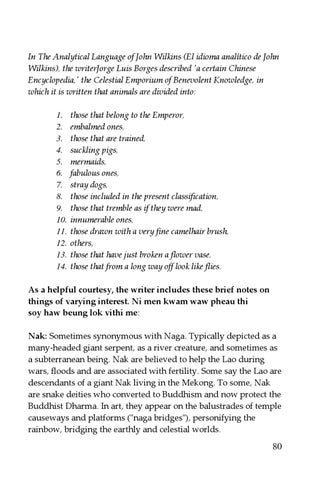In The Analytical Language of John Wilkins (El idioma analĂtico de John Wilkins), the writerJorge Luis Borges described 'a certain Chinese Encyclopedia,' the Celestial Emporium of Benevolent Knowledge, in which it is written that animals are divided into: 1. 2. 3. 4. 5. 6. 7. 8. 9. 10. 11. 12. 13. 14.
those that belong to the Emperor, embalmed ones, those that are trained, suckling pigs, mermaids, fabulous ones, stray dogs, those included in the present classification, those that tremble as if they were mad, innumerable ones, those drawn with a very fine camelhair brush, others, those that have just broken a flower vase, those that from a long way off look like flies.
As a helpful courtesy, the writer includes these brief notes on things of varying interest. Ni men kwam waw pheau thi soy haw beung lok vithi me: Nak: Sometimes synonymous with Naga. Typically depicted as a many-headed giant serpent, as a river creature, and sometimes as a subterranean being. Nak are believed to help the Lao during wars, floods and are associated with fertility. Some say the Lao are descendants of a giant Nak living in the Mekong. To some, Nak are snake deities who converted to Buddhism and now protect the Buddhist Dharma. In art, they appear on the balustrades of temple causeways and platforms ("naga bridges"), personifying the rainbow, bridging the earthly and celestial worlds.
80
